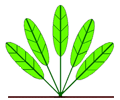


Darwin Algae Shrimp
Caridina sp NTnilotica
General information : This is an undescribed species of shrimp that was recently known to us as Caridina longisrostris until some specimens were sent to Dr Tim Page at Griffith University in Qld. Dr Page was kind enough to provide the following information after comparing our shrimps to his reference collection using DNA sequencing techniques. He wrote - Your C. longirostris from Leanyer Swamp, Buffalo Ck., Darwin Area groups very closely with a species that I informally call C. sp. NTnilotica see Page et al. 2007. It is not C. longirostris, which I also have in the tree. The other specimens that I have of C. sp. NTnilotica are all from NT Holmes Jungle, Daly River, Roper River - we are very grateful to Dr Page for his help. A very attactive small shrimp that needs to be kept with smaller non predatory fishes. It is an ideal species for the consumption of algae in the planted aquarium. It will not eat blue-green algae but loves the filament hair type. A good number of these in the new planted aquarium is a help with keeping the algae at bay. After they have used up all the algae they will feed on normal fish foods. The female is larger with colour, males are small thin and clear. I have seen the colours range from light green to red with a white stripe running from the rostrum to the tip of the tail.
Cultivation notes : Lives quite well in fresh water and consumes algae and other detritus, good for clean up of unwanted food left overs. It does not reproduce very well in freshwater, however some juveniles do survive. There is no research for reproducing this species however it appears to be similar to some other Atyiid shrimps in that it needs a marine or brackish phase in its life cycle. To produce numbers of this shrimp its larvae are raised in brackish ponds with the salinity over 17 ppt with high DO levels and algae production via a good fertilisation schedule. Once the larvae are through their first few moults and resemble their parents they are changed over to fresh water.
Distribution : NT
Selling details :Sold as individuals at or larger than 15 mm, minimum order 5
Reference: Communication with Dr Tim Page, Griffith University, Qld. Page et al (2007), "Molecular Phylogenetics & Evolution 43:pp.645-659 "